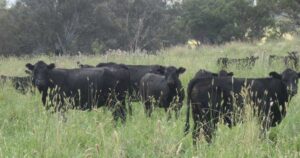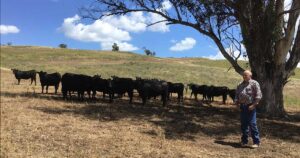HeiferSELECT integral to production at Burindi Station


Burindi Station is located in northern New South Wales’ North West Slopes and serves as a key component to the Paraway Pastoral Company’s central breeding operations.
Purchased by Paraway in 2008, Burindi is located near Barraba and makes up 18,000 hectares of undulating and steep hill country, forged on basalt and loam soils.
Managed by Richard and Ruth Puddicombe for 15 years, Burindi is a self-replacing Angus herd joining 8,000 Angus females annually, calving down 6,000 head and running terminal followers through to feeder weights.
“I have worked for Paraway Pastoral Company now for 15 years at Burindi, since its purchase in late 2008,” said Mr Puddicombe, better known as Pud. “I have been in the beef industry all my working life, at times in company with a greater portion of sheep.”
With Angus pivotal within the Burindi operation, all breeders in Paraway’s central locations are bred to be high indexing cows, with all Angus heifers joined to Wagyu genetics.
“The benefits of Angus versatility are there for all to see, and as Paraway is targeting the feeder market, Angus is an obvious choice,” said Pud.
The breeding season at Burindi starts in September, with bulls going out for joining on the 11-13th of September, for a June 20th drop calf. Bulls are left in longer than typical to suit value add markets for later joined PTIC cows.
Additionally, the Burindi operation has served as an Angus Sire Benchmarking Program (ASBP) co-operator cow herd for nine years and as part of this artificially inseminated (AI) 500 females to various Angus sires annually.
“As a co-operator herd for the ASBP, AI’ing 500 females to different Angus sires proved very educational in revealing the accuracies of Estimated Breeding Values for the average of bulls traits,” said Pud.
“Running multiple bulls commercially, it is the average that is important. Understanding this has many benefits to our production system.”
Further to this, the operation has recently trialled AI’ing Angus heifers with male sexed Wagyu semen.
 Within their management practices for their breeding herd, in the leadup to, during and after joining, Pud seeks to employ a rising plane of nutrition for the females.
Within their management practices for their breeding herd, in the leadup to, during and after joining, Pud seeks to employ a rising plane of nutrition for the females.
For their terminal progeny, the operation sells Angus Steers and Mixed Sex F1 progeny into the feeder markets, “We try and average heavier end of feedlot specs in the good times, and tip them out at the lower end during the dry times,” said Pud.
The herd maintains EU accreditation, citing extra demand and small premiums for EU feeder steers.
With the feeder operations of the business, there are pressures placed on the upbringing of these progeny to ensure the continuation of genetic improvement within the herd.
“We like our feeder cattle to only have the one Christmas with us, so they make way for the next generation of calves,” said Pud.
Of the challenges this philosophy poses, he said, “The majority of similar feeder operations calve in the winter/spring period, and often the challenge is to get space at a feedlot when you need it.”
Furthermore, a standard is maintained across their herd in terms of their breeding objective, with bulls purchased on TACE EBV and Selection Index criteria, and females kept requiring certain index values from genomics through Angus HeiferSELECT .
For the selection of sires utilised within their program, Burindi emphasises fertility to complement their breeding herd and carcase traits to assist in the production of their feeder portion of the business.
 Within their female herd, Burindi has heavily utilised Angus HeiferSELECT, a genomic selection tool to help inform the selection of Angus replacement females in a commercial beef breeding operation. HeiferSELECT provides genetic predictions for 14 maternal, fertility, growth, feed intake, carcase and resilience traits, genetic prediction for cow-calf value, feedlot-carcase value and total breeding, Angus BreedCHECK (genomic breed composition prediction) and sire assignment.
Within their female herd, Burindi has heavily utilised Angus HeiferSELECT, a genomic selection tool to help inform the selection of Angus replacement females in a commercial beef breeding operation. HeiferSELECT provides genetic predictions for 14 maternal, fertility, growth, feed intake, carcase and resilience traits, genetic prediction for cow-calf value, feedlot-carcase value and total breeding, Angus BreedCHECK (genomic breed composition prediction) and sire assignment.
Paraway began utilising HeiferSELECT in a pilot test with Angus Australia on the total 2015 drop of Burindi heifers. As of 2024, Burindi now utilises HeiferSELECT to genomically test every Burindi bred Angus female.
“This product gives us scientific based ability to draft up our cattle into more and less important mobs,” said Pud.
“When we have environmental stress and need to quit cattle, we have a readymade mob.”
He continued, “We also know that cattle that we choose to feed or agist will truly represent the best of what we have.”
In relation to the selection decisions made for the genetics within their herd, Pud highlights that through HeiferSELECT, a reflection of these selection decisions can be identified through the HeiferSELECT outcomes.
“Going back to the fact that it’s the average of the mob, not the individual that’s important in our commercial operation, HeiferSelect has been a great innovation and very well aligned to achieving goals for the Burindi herd.”
About Paraway:
Paraway Pastoral Company currently operates 30 pastoral and farming enterprises across a number of diversified climatic zones and a range of country types, with a collective capacity to carry over 220,000 cattle and 250,000 sheep. Thus, Paraway’s production focus is primarily red meat.
With Bos Indicus cattle in Queensland, Bos Taurus, particularly Angus cattle, in Northern NSW and Sheep in southern NSW and Victoria, all three featured regions in the company structure have a breeding and finishing structure and strategy.
Cheyne Twist, Senior Marketing and Communications Officer